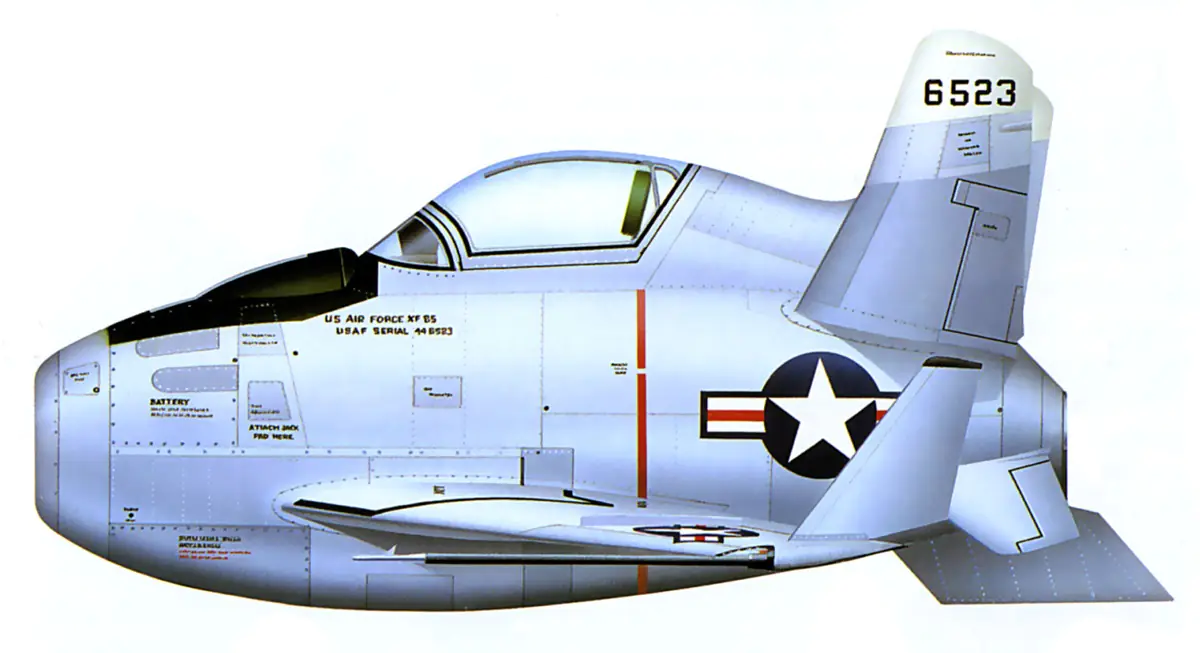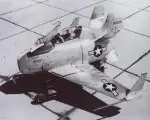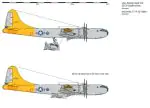After World War II, the era of jet aviation began. Nuclear weapons became the primary deterrent for the two opposing blocs – the communist USSR and the USA along with Western European countries, which were beginning to form the NATO alliance. In the late 1940s and early 1950s, heavy bombers were the main carriers of atomic weapons. With the increased range of these bombers, there arose a need to protect them from enemy fighter attacks. One method of defending bombers, whose range exceeded that of standard escort fighters, was to use onboard fighters. The XF-85 Goblin was the first and only jet-powered onboard fighter to be developed.

The design of the fighter envisioned it being stowed halfway into the forward bomb bay of the Convair B-36 strategic bomber, which had a length of just 4.9 meters.

As a result, the dimensions of the XF-85 Goblin were restricted. To ensure sufficient clearance for the fighter to be deployed and retrieved, the aircraft’s length had to be no more than 4.6 meters. Thus, the XF-85 essentially became a winged turbojet engine, the Westinghouse J-34-WE-22 with a thrust of 1,360 kg, on which the pilot literally sat on top.

Read also: Lesser-Known Pages of Aviation History: Northrop XP-79B “Flying Ram” – The Ramming Attack Aircraft
Due to dimensional limitations, the volume of the pilot’s cabin was only 0.74 m³, so the pilot’s seat could not be made height-adjustable, but it was possible to adjust the sight and the pedals. The operating altitude of the B-36 carrier bomber was as much as 13,000 m, therefore, despite the small volume of the cabin, its heating, pressurization and supercharging were provided. In addition, the XF-85 Goblin was equipped with a high-pressure oxygen system and a cylinder with a reserve of oxygen for the pilot’s breathing in case of an emergency abandonment of the aircraft. The pilot rescue system was one of the first versions of the T-4E ejection seat.
The XF-85 fighter’s delta wings folded before being stowed in the bomber’s bomb bay. To avoid a folding tail and to provide the necessary surface area while keeping the dimensions minimal, the fighter was initially equipped with five tail stabilizing surfaces. These surfaces were arranged radially around the rear of the fuselage, with two of them serving as combined elevators and rudders. However, it was later discovered that this number of tail fins was insufficient to ensure the necessary stability, so an additional three were added to the aircraft.
Read also: Autopilot in Aircraft: History and How It Works
One of the two XF-85 fighters made its first flight on August 23, 1948, from a modified Boeing B-29 bomber. However, the fighter could not be retracted back onto the bomber, and the pilot was forced to land it using a skid at a speed of about 270 km/h.
Main technical specifications of McDonnell XF-85 Goblin:
- Maximum speed: approx. 835 km/h
- Maximum flight altitude: 13 000 m
- Weight of an empty airplane: 1430 kg
- Length: 4.5 m
- Height: 2,5 м
- Takeoff weight: 2190 kg
- Wingspan: 6.5 m
- Wing sweep: 37 ° along the leading edge
- Armament: four Colt-Browning M 12.7 mm machine guns with 300 rounds of ammunition each
Read also: “Invisible” Aircrafts: How Stealth Technology Works in Aviation














